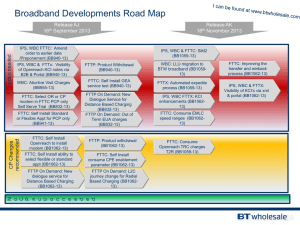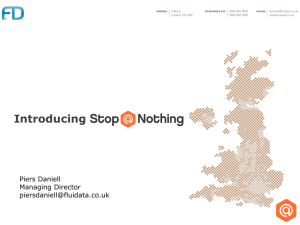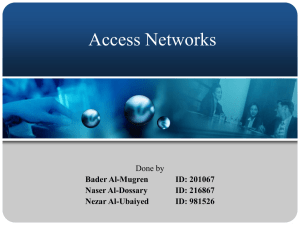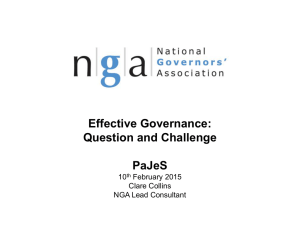Presentation - European Telecom, a Trendy Investment Target Again?
advertisement
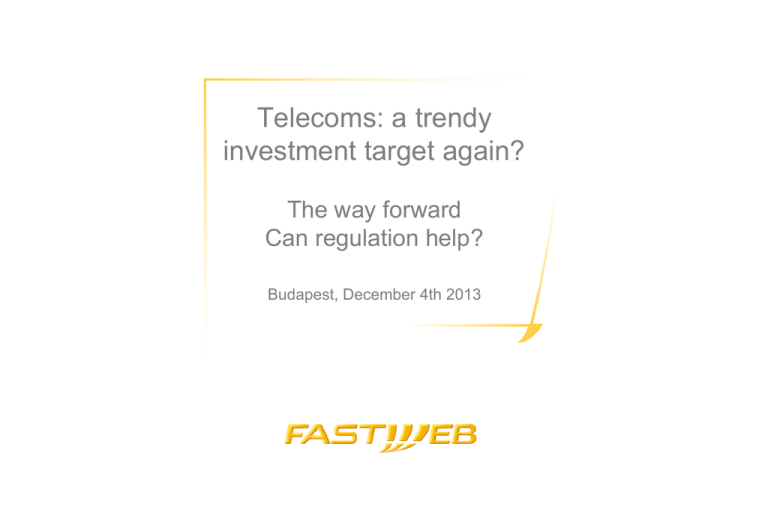
Telecoms: a trendy investment target again? The way forward Can regulation help? Budapest, December 4th 2013 Fastweb’s unique positioning in the NGA market 1.8 million households passed by proprietary FTTH in 7 cities Extensive LLU coverage in over 1000 local exchanges Bergamo Brescia Milano Pisa Livorno Thanks to end-to-end control of infrastructures, first operator in itlay to launch 20 Mb/s service and 100 Mb/s (in 2008) Since 2012 first Altnet in Europe to massively deploy FTTC: 3.5 million households covered by 2014 in 20 cities Trieste Verona Padova Reggio Emilia Venezia Bologna Ancona Firenze Roma Bari Napoli 2,5 Mln Tablet WiFi FW FTTS footprint Palermo 2,3 Mln Connected TV FW FTTH footprint Would the Connected Continent package foster investments? The assumptions Telecom sector declining in Europe, while growing steadily in other areas of the world, due to “too many operators” and too much regulation… Sector profitability and investments can be boosted by supporting consolidation and reducing competition through more relaxed rules on SMP and by privileging VULA versus physical access Measures proposed would increase the market power of incumbent operators and limit the possibility of infrastructure-based competition by Altnets The new approach to identify relevant markets will progressively reduce the scope of access regulation Considering LTE as a competitive constraint would impact on the identification of markets subject to ex-ante regulation even in countries with low or no cable penetration. Reducing the scope of access regulation will eventually lead to re-monopolization of fixed market in many countries and/or regions. Fixed broadband would be offered by one, maximum two operators (incumbent/cable) in most countries Are we going back to square one? one? Favoring virtual vs. physical access provides vertically integrated operators a monopoly in deploying NGA FTTS - the new paradigm for NGA deployment - requires Altnets to deploy fiber only to the cabinet and use the legacy copper network from the cabinet to the user premises Unlike FTTH, FTTC is quick to roll out and financially sustainable also for operator with a limited market share. Altnets can play this game! Fiber (1500 m) FTTH Street cabinet FTTC/FTTS fiber copper sub-loop (400 m) Limiting access to sub-loop would curb Altnet’s capability to deploy NGA and reduce infrastructure-based competition in NGA Will consolidation and a reduced competition support profitability and increase the incentives to invest? Performances of fixed operators in EU and US are comparable Ebitda on sales – 2012 (fixed operations only) 60% 50% 40% 48% 38% 30% 30% 31% 27% 21% 20% 10% 0% Telecom Italia Telefonica Deutsche Telecom Source: Deutsche Bank 2012; Bernstein Research 2012 France Telecom At&t Verizon Source: At&t Financial report , Verizon financial report Limited competition determines low degree of innovation… Areas not covered by BB Areas covered by a single DSL provider Areas covered by more than one provider • Most US users have a very limited choice of one DSL provider and one cable operator • Extended areas not reached by any DSL provider Areas covered by fibre • FTTx connections are only 2% of total (OECD, 2012) Limited competition doesn’t seem to imply higher profitability or more investments… Source FCC broadband maps www.broadbandmap.com 9 … high retail prices for comparatively poor services… Cheapest broadband package available* AT&T VERIZON COMCAST Advertised speed 3 Mbps 1 Mbps Intro price/month 29,95 $ 19,99 $ Standard price/month 41,00 $ n.a. Usage cap/month 250 GB Source: operators’ commercial websites – 16th July 2013 TWC 20 Mbps 1 Mbps 39,99 $ 19,99$ 42,95-64,95 $ n.a. - - Retail prices higher than in EU, also for basic speeds Highest speed broadband package available* AT&T Very limited availability of ultrabroadband packages, at very high prices TWC Advertised speed 24 Mbps 150 Mbps 105 Mbps 50 Mbps Intro price/mo 54,95 $ 134,99 $ 89,99 $ 74,99 $ Standard price/mo 66,00 $ 134,99 $ 114,95 $ n.a. - - Usage cap/mo *All prices exclude local taxes VERIZON COMCAST 250 GB Source: operators’ commercial websites – 16th July 2013 …and business models that will reduce the degree of innovation Thanks to limited competition, fixed broadband providers are increasingly moving away from flat fees and introducing data caps, at the expenses of consumers and innovation …but it’s definitely bad news for end users.! The other side of the story: the critical role of Altnets in triggering the race to fibre Competitive pressure is the only driver for investments in NGA Most EU countries feature low or no cable penetration: reducing Alnets capability to compete effectively would destroy any incentive for the incument to deploy NGN HH planned to be FTTH ready by 2012 (000) Telecom Italia’s planned FTTH coverage for 2012 based on 2009-2012 TI’s plans 1200 1000 980.00 800 600 400 295.70 266.30 200 34.45 0 jan-10 dec-10 aug-11 FTTH Investment planned for 2012 9.5 9 8.5 8 7.5 € 7 6.5 6 5.5 5 The italian case is the perfect example: despite LLU price increase in 2009-2012 (and therefore increased profitability), TI plans to deploy FTTH have been constantly reduced and eventually completely scrapped…. feb-12 LLU price For former monopolist, first best is maintaining the status quo and leveraging existing asset, not investing in NGN…. Fastweb FTTC plan: a game changer In 2011 Fastweb started to develop a plan to deploy FTTC to increase its existing FTTH NGA footprint Negotiation with Telecom Italia were launched to access street cabinet. Fastweb’s plan to massively deploy FTTC in 20 italian cities (increasing its overall FTTx coverage from 2 mln hh to 5.5 in 2014) played a key role in shaping Telecom Italia’s own NGA plans Telecom Italia developed its own plan to roll-out FTTC, overlapping existing and planned Fastweb’s NGA footprint Telecom Italia and Fastweb signed an MoU to reach synergies in the deployment of their respective FTTC networks In september 2012 Fastweb and TI announced final plans to deploy parallel FTTS networks. Thanks to its FTTC network Fastweb offers speeds three times higher than Telecom Italia >70 Mbps Average downstream for 80% of active FTTC customers >90 Mbps Average downstream for 40% of active FTTC customers 15 November 2013: Vodafone joins the race to fiber! 1,8 billion€ earmarked to develop fixed and mobile NGA in Italy (3.6b in the next two years) On top of already planned LTE investments, Vodafone will dedicate part of the resources to cover 150 italian cities with FTTC, with the objective of reaching 6,4 milions of hh (25% of the population) Competition and availability of physical access services are key to create the right incentives for investments No virtual product can be equivalent to physical access Access to LLU/SLU • Altnets can provide BB and UBB services beyond the incumbent’s footprint • Altnet choose the active technology (VDSL, Vectoring, G-Fast etc.) • Altnets can upgrade speed an QoS any time they want • Altnets free to install technical equipment of their choice Virtual access • Altnets are limited by the incumbent VULA’s geographical coverage • Incumbent decides technology: altnets cannot install any equipment that is different (more performing) than incumbents’ • Altnets’ can chose the performance to offer to endcustomers within a predetermined and limited range of speeds and QoS features Physical access services are key enabler of infrastructure-based competition • LLU played an essential role in allowing Altnets to compete effectively with the incumbent and to innovate • Thanks to its end-to-end control of the network Fastweb was able to offer higher speeds and better QoS than the incumbent on copper lines, compete on differentiation (rather than prices), • SLU will enable Fastweb and other Altnets to invest in FTTC to apply the same competitive pressure on NGA products Maintaining SLU and setting the right price will be critical to maintain the right incentive to invests for all SLU and vectoring can coexist! Speeds enabled by non-vectored VDSL2+ are in many cases already in line with DAE targets Multi-operator vectoring is a reality and can be easily achieved through the right regulatory policy!
